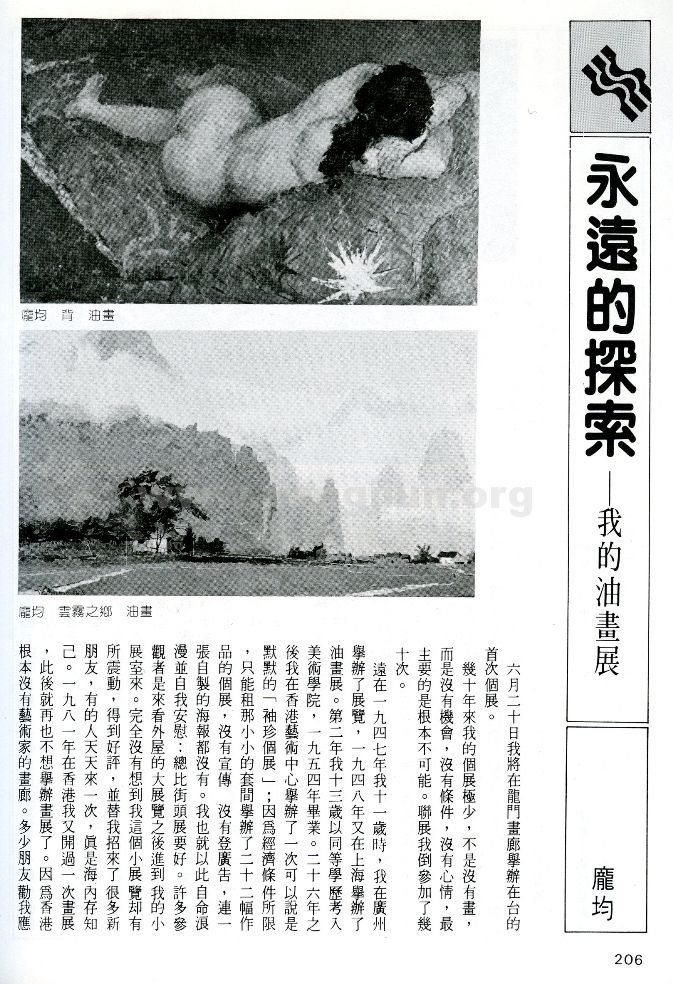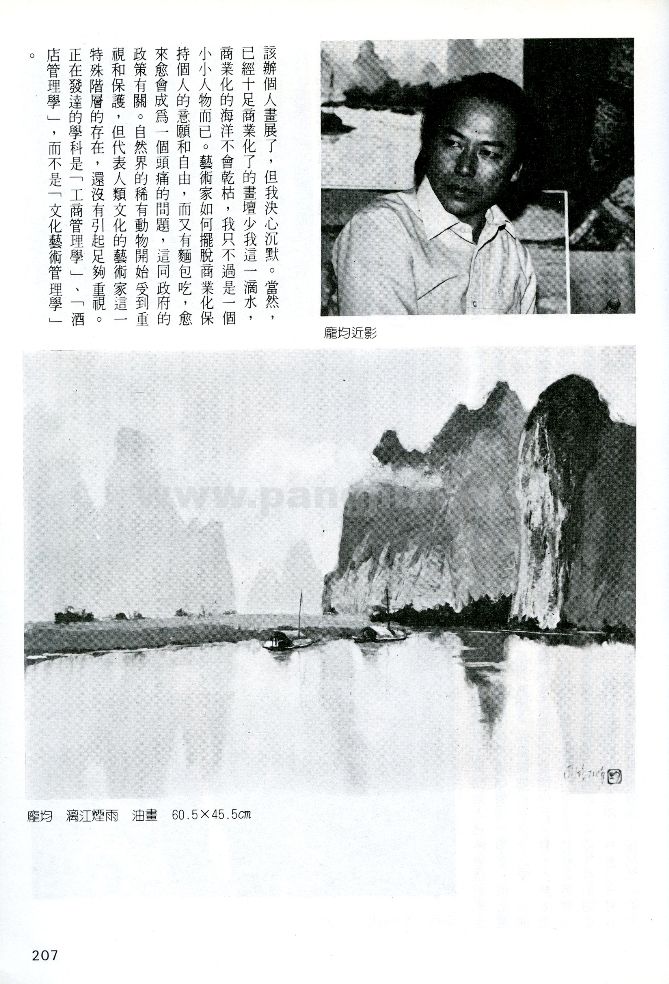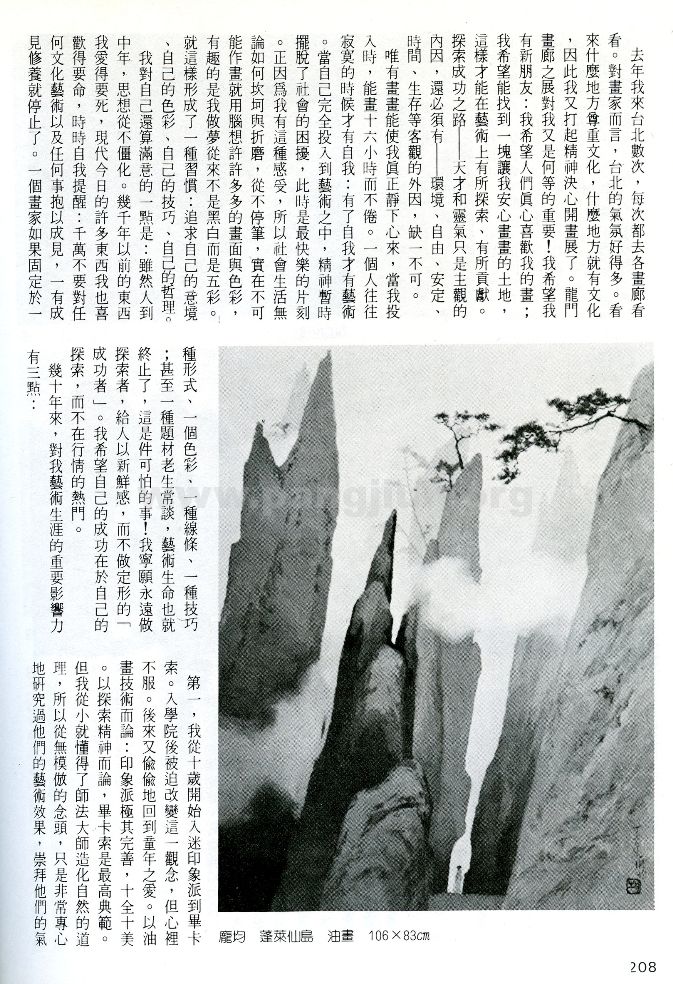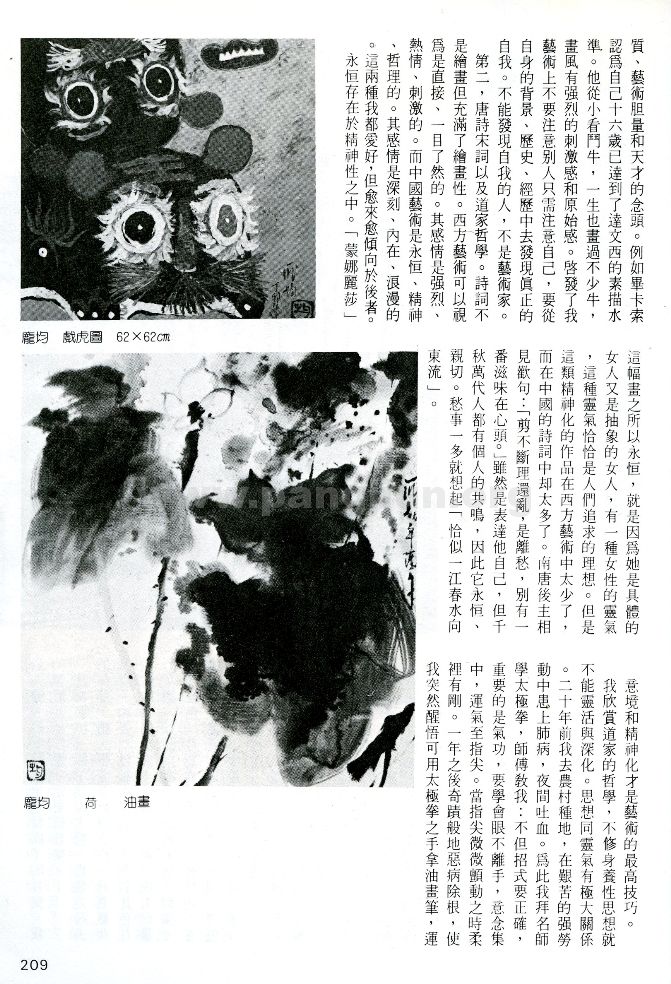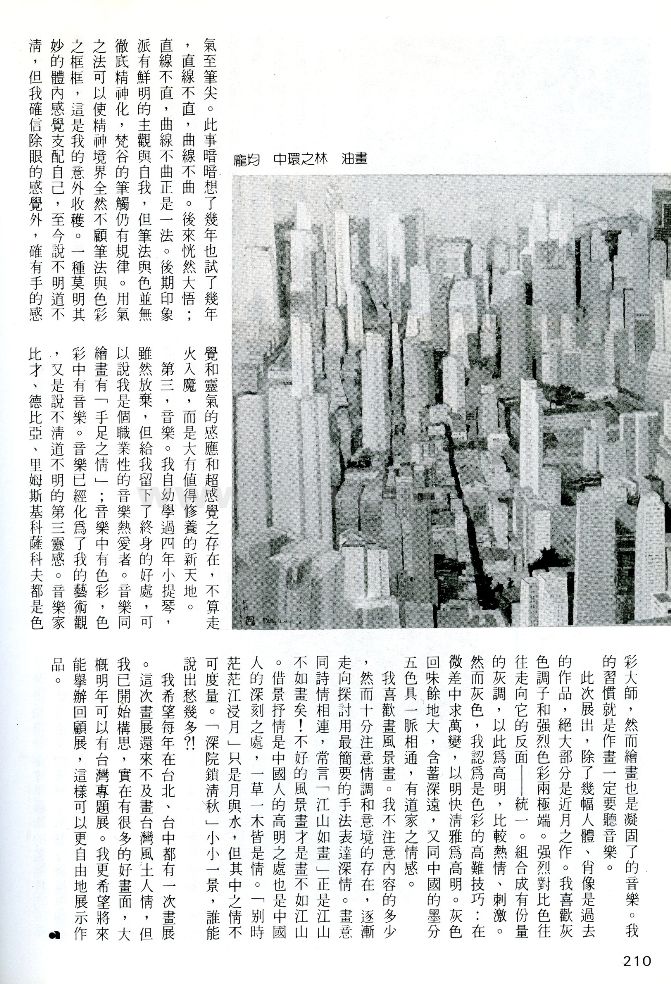 CLOSE
CLOSE
My first solo exhibition is opening in Taiwan on June 20 at Lung Men Gallery.
I rarely organize solo exhibitions, not because I have no new works, but because I simply don’t have the opportunity, the conditions, nor the mood, to organize them. But above all else, it’s just not practical for me. However, I have participated in many of group exhibitions.
My very first exhibition was held in Guangzhou, back in 1947 when I was only eleven years old. In 1948, I held another oil painting exhibition in Shanghai. The next year, when I was thirteen, I passed the entrance exam to the Central Academy of Fine Arts with equivalent qualifications, and graduated from the academy in 1954. Twenty-six years later, I quietly held a “mini solo exhibition” in Hong Kong at the Arts Centre. At the time my economic condition would only allow for a solo exhibition with twenty-two pieces in a small gallery. There were no commercial activities nor advertisements, there wasn’t even a simple hand-made poster. I comforted myself by romanticizing the event; I kept telling myself it was better than showing my works on the street. Many visitors bumped into my exhibition by chance, as they were on their way to see a larger exhibition in the outer gallery. Surprisingly, my mini exhibition did receive some responses and praises, and introduced many new friends to me. Some of them were so kind that they came everyday to see my works. In 1981 I held another exhibition, after which I had had no intention to organize solo shows anymore because Hong Kong did not have any galleries dedicated to artists. Against the advice of many friends, I remained dormant. The highly commercial galleries certainly did not cease their operations due to my absence – I was only a small potato. What was becoming a common problem was for artists to balance their own ideas and artistic freedom with economic security. This was related to the government’s policy. While rare animals in nature become increasingly valued and protected, the special class of artists as representatives of human culture have not gained enough attention. The disciplines that flourish are usually business administration or hospitality and management – not art and culture management.
I came to Taipei several times in the last year, and each time I visited a few galleries. Artists usually feel better in Taipei – how different the two regions differ in terms of culture. Encouraged by the atmosphere, I again decided to hold an exhibition – how important the show at Lung Men Gallery was to me! I hoped it would attract new friends who would sincerely appreciate my paintings; I hoped to find a place to settle down to paint and to explore and contribute to art. Success not only requires subjective factors such as ingenuity and cultivation, but it also depends on objective factors such as the environment, freedom, security, time, and existence. Both factors are indispensable.
Only painting can really calm my mind. When I am concentrating on painting, I can work for up to sixteen hours nonstop. When you live alone, you have a self, and therefore you have art. As you are totally occupied by art, your mind, in its happiest state, is temporarily liberated from social concerns. It is precisely for this moment that I never stop, despite the difficulties and sufferings going on in my social life. It is certainly not possible for me to conceive compositions and colors at any time when I paint; interestingly, I have always had colorful dreams, rather than black-and-white ones. It has been a habit of mine to habit to seek my concept, my colors, my techniques, and my philosophy.
I am content with myself in one aspect: although I am already middle-aged, my mind is never rigid. I love the thousand-year-old relics as much as I appreciate modern inventions. I constantly remind myself that I should never view cultural and artistic topics, or virtually anything, with preconceptions. Cultivation stops before preconceptions. If an artist clings to a single form, color, line, technique, even clichéd subject, his or her art life stops. This is terrible! I would rather be an explorer bringing new things to people, than a “winner” who never evolves. I hope that my success lies in exploration, and not in the price or popularity of my works.
In the past few decades there has been three major influences on my career.
First, I have been attracted by Impressionism and Picasso since I was ten years old. I was forced to change after I entered the academy. Unconvinced, I quietly returned to them later. Impressionism is superb and perfect in technique, and Picasso is the pinnacle of this notion. Knowing that nature is my ultimate teacher, however, I never intend to imitate them, except for studying their aesthetic effects diligently, and admiring their spirit, courage and genius ideas. Take Picasso for example. He thought that he had achieved what da Vinci had achieved in sketching when he was sixteen years old. He watched bullfights in his childhood, and had painted numerous bulls with a strong style and primitive atmosphere. It reminds me of the necessity to focus more on myself than on other people. I must find myself from my background. my history, and my experiences. Without the ability to find yourself, you cannot be an artist.
Secondly, I am attracted by Tang and Song poetry and Taoist philosophy. Poetry is not a painting, but is pictorial. Western art is direct and straightforward; its emotion is intense, passionate and exciting. Chinese art, by contrast, is immortal, metaphysical, philosophical; its emotion is profound, quiet, and romantic. While I appreciate both styles, I am more and more drawn to the latter.
Immortality lies in spirituality. “Mona Lisa” is immortal because the subject is both real and abstract. It reveals a female quality that is the ideal of people. While the works depicting spiritual quality are rarely seen in the West, spiritual depiction floods the Chinese poetry. One example is “Joy of Meeting” by the Southern Tang poet Li Yu, “You can’t cut it, it remains tangled. The sorrow of parting has a special taste in my heart.” Although it is a personal expression, subsequent generations find reverberations in their minds. It is therefore immortal and intimate. As we are sorrowful, we recall the line, “like a spring river flowing east.”
Profundity and spiritual depiction are the highest merits of art.
I admire Taoist philosophy. Without philosophical cultivation, one cannot broaden and deepen one’s mind, which is closely related to one’s spiritual growth. Twenty years ago when I was forced to farm, I contracted lung disease through hard labor, and vomited blood at night. It was then that I began to study Tai Chi from a famous teacher, who in addition to the correct moves, taught me the importance of transmitting your chi to your fingertips. When your fingertips begin to quiver slightly, it is because they are quivering from the force. One year later, my disease was miraculously gone. An idea struck me: I can move the paintbrush by transmitting my chi to the fingertips in the way of Tai Chi. I had harbored the idea and secretly experimented with it for several years, but this only resulted in crooked lines and distorted curves. Later it dawned on me that this is precisely how things should be. Despite their distinctive characters and strong styles, the post-Impressionists did not render entirely spiritualized strokes and colors. There are still rules behind Van Gogh’s strokes. My experiment with chi had accidentally enabled me to break the confines of strokes and colors in a spiritual way. An inexplicable force dominates me from inside my body. I am unable to express this feeling through words, but I believe that the process involves not only my eyes, but also my hands and the force and an extrasensory perception. This is not some obsession, but a new world worth exploring.
Finally, there is music. I studied violin for four years in my childhood. Although I gave it up later, the experience has given me a lasting benefit. You can say that I am a professional music lover. Music and paintings go hand and foot: there is color in music, and music in color. Music has already become embedded in how I view art, and it has given me a mysterious and unexplainable type of inspiration. The composers Bizet, Debussy, and Rimsky-Korsakov are also masters of color. Conversely, paintings are frozen music. I use the two together, as I’ve developed the habit to listen to music while I paint.
The works on display in this exhibition are mostly recent paintings, except for a few drawings of bodies and portraits which are from the past. I prefer both grey tones and strong colors. Strong contrasting colors often paradoxically result in union. Heavy emphasis on grey tones can be quite clever and contribute to a piece of work’s passion and stimulus. However, I think grey tones can be difficult to handle: to seek change in subtle nuances, the use of gray can be quite profound, resonating with the Taoist concept of five colors of ink.
I enjoy painting landscapes. I don’t pay too much attention to the how much content there is, but instead, I pay particular attention to the mood that is present, as I am increasingly inclined to use the simplest techniques to express the deepest emotions. Painting is connected to poetry, as the Chinese saying goes, “A beautiful landscape painting is no less beautiful than the actual mountains or rivers it portrays; only poorly painted landscapes are inferior to natural ones.” Borrowing lyrics to express the beauty of a landscape is what Chinese paintings do best – every grass and every tree contains emotional connotations. Between the moon and ocean lay unfathomable emotions. From another painting, in such a small autumn courtyard, how is it that one can feel so much sorrow?
It is my hopes to hold annual exhibitions in Taipei and Taichung. It is too late in this current exhibition to include paintings on Taiwan culture and customs, but I have already begun to plan this for in a special exhibit that will be held in Taiwan next year – already a lot of good pictures have come to mind. Moreover, in the future I wish to organize a retrospective exhibition, which may allow me more freedom to choose what works I want to exhibit.
